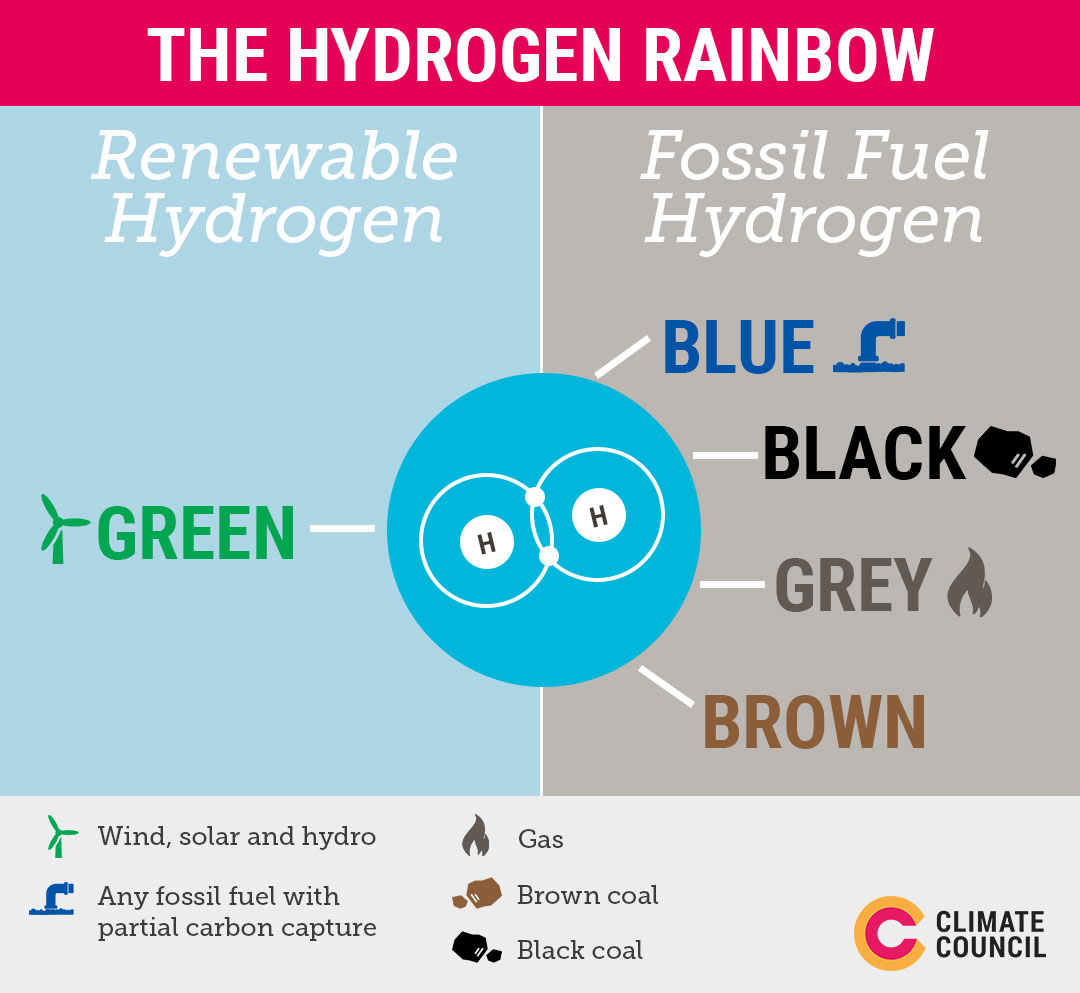Renewable hydrogen: Australia’s key to net zero emissions, booming export industry
Hydrogen is now prominent in our energy debate and no doubt you have heard the terms ‘renewable’, ‘green’, or ‘clean’ attached to it. Not to mention,’ brown’, ‘black’, ‘grey’ and even ‘blue’.
The reality is that only ‘green’ or ‘renewable’ hydrogen – hydrogen generated by renewables – belongs in our zero emissions future. The good news is, as one of the sunniest and windiest countries in the world, we are well-placed to be a renewable energy powerhouse.
Key points:
- Only renewable hydrogen, generated through solar and wind, can play a major role in our zero emissions future.
- Watch out for the term ‘clean hydrogen’ – it’s often used in a purposefully misleading way, and can include fossil fuel use.
- Hydrogen produced using renewable energy will help lower Australia’s emissions, drive a booming export industry, and help replace fossil fuels in some energy-intensive sectors like heavy freight transport and industries such as steel and fertilisers.
- Australia has a significant opportunity to become a renewable hydrogen powerhouse, which is key to unlocking other clean industries such as green metal production and green ammonia.
- As one of the sunniest and windiest countries in the world, why would we invest in any other type of hydrogen?
What is hydrogen?
Hydrogen is the first element in the periodic table and the most abundant element in the universe. When the term ‘hydrogen’ is used in the energy sector, it refers to a simple molecule of two hydrogen atoms: H2. Creating molecular hydrogen uses a lot of energy, and splitting it apart releases that energy again. This means that producing hydrogen, and then using it, works a little like charging and discharging a battery.
Hydrogen will not outperform a conventional battery in many areas. That said, there is potential for hydrogen to replace fossil fuels in activities that are especially emissions-intensive, such as steelmaking, or where other zero-emissions solutions are being scaled up, such as long-range transport. Hydrogen can be used in many other sectors as well, from fertiliser production to fuel cells in trucks and ships.
What are the different types of hydrogen?
Different types of energy can be used to produce various types of hydrogen:
‘Green’ – renewable energy
‘Brown’ – brown coal
‘Black’ – black coal
‘Grey’ – gas
‘Blue’ – any fossil fuel with carbon capture and storage
‘Clean’ – a recently coined, and often purposefully misleading, term that could describe either ‘green’ or ‘blue’ hydrogen

Brown, black, grey and blue hydrogen all result in significant greenhouse gas emissions and so contribute to climate change when produced at scale.
Watch out for ‘clean’ hydrogen
It sounds good in theory, but the new term ‘clean hydrogen’ can be misleading. In recent times, proponents of fossil-fuelled hydrogen have used this to describe fossil fuel hydrogen linked to carbon capture and storage (CCS), as well as renewable-sourced hydrogen.
Carbon capture and storage is, and will always be, incapable of providing a zero-emissions energy supply when attached to highly polluting coal and gas projects. This includes its use in the production of blue hydrogen. Developing a blue hydrogen industry would result in a massive new and unnecessary source of greenhouse gas emissions at a time when rapid and deep emissions reductions are critical to ensuring a liveable future. Producing hydrogen with fossil fuels will only push global temperatures higher and worsen climate impacts, including deadly bushfires and devastating floods.
Why renewable hydrogen?
While hydrogen is often referred to as ‘the fuel of the future’, it is only ‘renewable hydrogen‘ that can play a role in our zero emissions future. The good news is, renewable hydrogen is available now, and it is an opportunity multiplier that will help unlock other green industries such as green iron and ammonia, and end industry’s reliance on fossil fuels.
Australia’s opportunity: a global renewable hydrogen superpower
Today, Australia is one of the world’s largest coal exporters and the largest liquefied gas exporter. Both are polluting fossil fuels, and Australia is paying a high cost for that with more severe and frequent extreme weather events like bushfires, heatwaves, and drought. As the world moves to decarbonise, these exports are on notice.
The good news is, renewable hydrogen is a major economic opportunity for Australia as we phase out coal and gas exports.
Renewable hydrogen, made with Australia’s abundant solar and wind resources, is a major economic opportunity for Australia as our coal and gas exports are phased out. From chemical manufacturing and transport to industrial heat and metal refining, renewable hydrogen could play a role in reducing the climate impact of a number of sectors. A renewable hydrogen industry has the potential to increase the total value of our economy, unlock other green export industries such as iron, steel and ammonia, and provide jobs for Australians where they need them most.
Already, major economies like Germany and Japan are trying to cash in on Australia’s renewable hydrogen export potential. Both countries, along with Australia’s other major trading partners, have a net zero emissions target and are only interested in importing truly renewable hydrogen. Additionally, the United States has charged ahead with the opportunities of renewable hydrogen, with low-emissions hydrogen being subsidised under the recently passed Inflation Reduction Act, the largest climate spend in American history.
There are promising first signs that Australia will realise its potential as a renewable hydrogen powerhouse. The 2023/4 Federal Budget committed $2 billion to a new Hydrogen Headstart program to scale up the development of Australia’s renewable hydrogen industry. But more must be done for Australia to meet its full potential as a green energy superpower.
Australia is already living in the age of climate consequences, with devastating bushfires, floods, droughts, and extreme heat happening with increasing frequency and severity, along with alarming damage to critical ecosystems including the Great Barrier Reef. Decisive action on climate change this decade and a rapid transition away from fossil fuels are critical to limit future harms.










